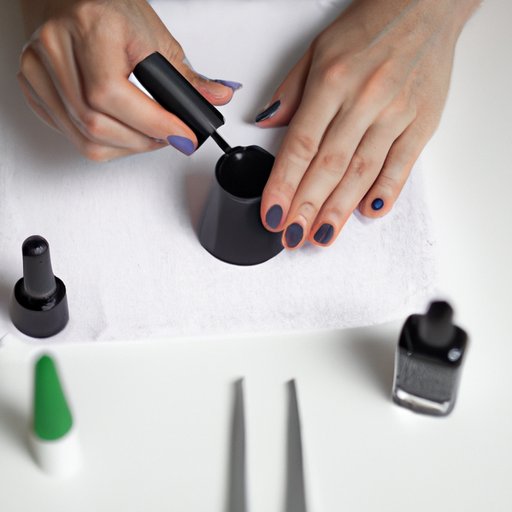Introduction
Acrylic nails are artificial nails that have been applied over the top of natural nails to create a longer, more attractive look. They are made from a combination of liquid monomer and powder polymer, which is then shaped and hardened into a nail. While they can be a great way to enhance your appearance, there may come a time when you want to remove them.
Removing acrylic nails can be tricky and time consuming, and it’s important to understand the potential risks involved. This article will explore five different methods for removing acrylic nails, and provide advice on how to do so safely and effectively.
Soaking in Acetone Solution
The most commonly used method for removing acrylic nails is to soak them in an acetone solution. Acetone is a powerful solvent that can break down the bonds between the acrylic nail and the natural nail. It is available in a variety of forms, including nail polish remover, nail soak, or even pure acetone.
To use this method, start by trimming the length of the acrylic nails as short as possible. This will help the acetone to penetrate the nails more easily. Next, put some cotton wool soaked in the acetone solution onto each nail and wrap the finger tightly in foil. Leave the nails to soak for around 15 minutes, before carefully unwrapping the foil and pushing off the softened acrylic.
This method is relatively quick and straightforward, although it can be quite smelly and drying on the skin. It’s also important to be careful when handling the acetone solution, as it can be quite flammable.

Using an Acrylic Nail Drill
This method involves using a special type of electric nail drill to gently grind away at the acrylic nails. The drill is equipped with a selection of bits that can be used to file, buff, and sand down the surface of the nails. This process can take some time and requires patience, but it can be a good option if you don’t want to use any harsh chemicals.
It’s important to be very careful when using a nail drill, as it can cause serious damage to the natural nails if not used correctly. It’s also important to make sure the drill is set on the lowest speed setting, and to use protective gloves and eye protection.
Prying with a Cuticle Pusher
This method involves using a cuticle pusher to carefully pry the acrylic nails off the natural nail bed. Start by softening the acrylic nails with a cotton wool pad soaked in acetone solution. Once the nails are softened, use the pointed end of the cuticle pusher to carefully lift one edge of the nail. Keep lifting until the whole nail comes away.
This method can be quite time consuming, and requires patience and a steady hand. It’s also important to be careful not to dig too deeply into the nail bed, as this could cause damage.
Applying Acetone-Free Nail Polish Remover
If you’re looking for a gentler option, you can try using an acetone-free nail polish remover. These are specially formulated to break down the bonds between the acrylic nails and the natural nails, without causing any damage. To use this method, start by trimming the length of the nails as short as possible. Then, apply the nail polish remover to a cotton wool pad and hold it against each nail for several minutes. Finally, use the cuticle pusher to carefully pry the nails off.
This method is much gentler on the nails than using acetone, but it can take longer and may not be as effective. It’s also important to avoid getting the nail polish remover on your skin, as it can be quite drying.
Visiting a Professional Manicurist
If you don’t feel comfortable attempting to remove your acrylic nails yourself, it’s best to visit a professional manicurist. They will be able to safely remove the nails for you, using a combination of soaking and filing. This option is usually the safest and most effective, although it can be more expensive.
When visiting a professional, make sure to ask about their experience and training, and make sure they are using the correct tools and products. It’s also important to follow the aftercare instructions they provide to ensure your nails remain healthy and strong.
Conclusion
Removing acrylic nails can be a tricky process, and it’s important to take the necessary precautions. In this article, we have explored five different methods for removing acrylic nails, including soaking in acetone solution, using an acrylic nail drill, prying with a cuticle pusher, applying acetone-free nail polish remover, and visiting a professional manicurist.
Whichever method you choose, it’s important to take your time and be gentle. Make sure to moisturize your nails afterwards, and consider using a strengthening treatment such as biotin to keep them healthy.


